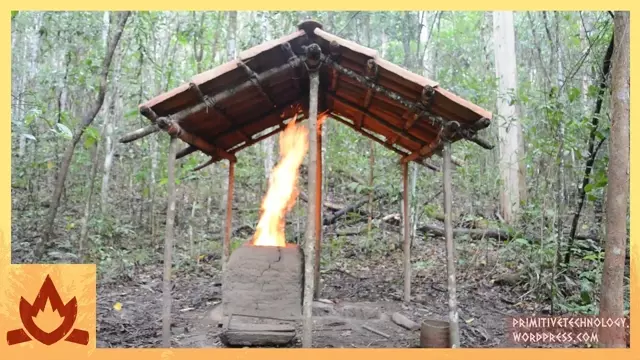2016-09-16
[public] 18.6M views, 287K likes, dislikes audio only
I built a tiled roof shed to provide a fire and rain proof shelter for working on projects during wet weather and for storing firewood. The shed houses the very kiln used to fire its own tiles.
I cut timber using the stone hatchet and took it to the building site. 6 Upright posts were stuck into the ground about half a meter. Mortices were cut into the horizontal beams using a stone chisel to start with, then had there mortices enlarged using hot coals and a blow pipe to burn them out more. These beams were put in place and rafters were lashed on with lawyer cane. The wood that the tiles sit on are about 50 cm apart. The finished frame was 2 x 2 m in floor plan, 2 m tall at the ridge line and 1.5 m tall at the sides. This roof angle is about 22.5 degrees, half the pitch of the huts I usually make. This took about a week but I did it about 4 months ago and left the wood at the site because I was busy on other videos
Next I made a kiln. I made a basket to make it easier to carry clay from the creek. I dug a trench for the firebox of the kiln and made a clay vault over it using stick arches to support it. Holes were put into the vault to let flames through. The kiln shape was a cube with a domed roof. It was made of mud on site (clay from the creek is too good to build a kiln with and is best used for pottery). Grate bars were put into the firebox to increase wood burning efficiency by letting air come up through the wood rather than over it. This only took about 3 days to build letting it dry slowly.
To make the tiles, clay was collected and had the sticks and stones taken out of it. Then I crushed up old broken pottery and tiles I made before which I mixed with the clays as grog (stops clay from cracking). A tile frame was made from a split piece of lawyer cane bent into a trapezoidal shape about 50 cm long, 20 cm at the wide end and 16 cm at the narrow end. This was put on a flat stone. Wood ash was put down to stop the clay sticking to the rock. The clay was pressed into the fame and the wet tile was slid onto a curved piece of wood to form the curved shape of the barrel tile. The tile was then moved immediately to a flat area and the piece of wood was slid out so the tile sat on the ground to dry. Being curved, air could get under the tile to help dry it out.
I could make 30 tiles easily in a day and only had 150 to make. But it kept raining and destroying the tiles before they dried. So I had to make 30 tiles, let them dry enough to be moved, then take them to the tiled hut where they were force dried on the ondol (fire heated bed). The majority of the time spent on this project was re-making broken tiles due to unseasonal rain (I don’t think we have a proper dry season here anymore, this is what held up my other tiled hut too). So this whole part probably took 4 weeks.
Firing the tiles was easy compared to the other tiled hut I built. I could fit 30 tiles in the kiln at once and had 150 tiles to fire. The 5 firings took 5, 4.5, 3.5, 4.5 and 3.5 hours. The first one probably took longer due to the kiln not being dry yet and the 4th firing took a while due to wet firewood. Tiling the roof was also easy. Starting at one end, tiles were laid so that the concavity faced up and the narrow end pointed into the next tile below acting like a shoot for water to run down. The gaps between these tiles was covered using a tile with the concavity facing down and the narrow end pointing up under the next tile above. The ridge of the hut was covered with the same tiles interlocking to keep rain out. The low roof pitch, the weight and friction of the tiles, the fact that they interlock all help to keep the tiles in place meaning they don’t need tabs or pegs to hold them in place.
The roof sheds rain and is fireproof. This will provide a workplace for fire related projects in all weather. Walls were not built as this is a place for working and storing firewood, not sleeping and staying warm. Also, light can come in so it’s easy to see during work. The kiln worked ok and was able to handle a larger volume of tiles than the previous kiln I built (having over 4 times the volume) though I might investigate better kiln designs in future to attain higher temperatures and use less firewood. The roof of this shed has a lower angle to my other huts meaning it has more headroom. Ideally barrel tiles should be used at about 30 degrees as opposed to the 22.5 I used but being a small shelter I don’t think the water will build up and seep through. A large house would use a slightly steeper angle.
Wordpress: https://primitivetechnology.wordpress.com/
Patreon page: https://www.patreon.com/user?u=2945881&ty=h
I have no face book page. Beware of fake pages.
http://www.penguinrandomhouse.com/primitive-technology
/youtube/video/VVV4xeWBIxE?t=186
/youtube/video/qEUGOyjewD4
/youtube/channel/UCAL3JXZSzSm8AlZyD3nQdBA
/youtube/video/nG-rNHgFxhs
/youtube/video/eesj3pJF3lA
http://www.penguinrandomhouse.com/primitive-technology

